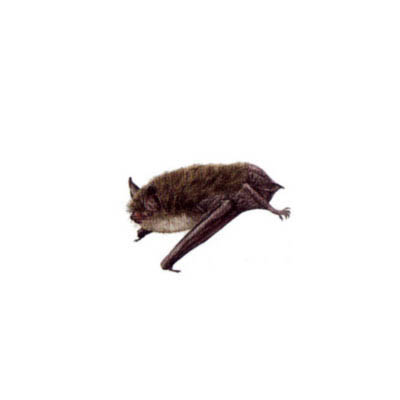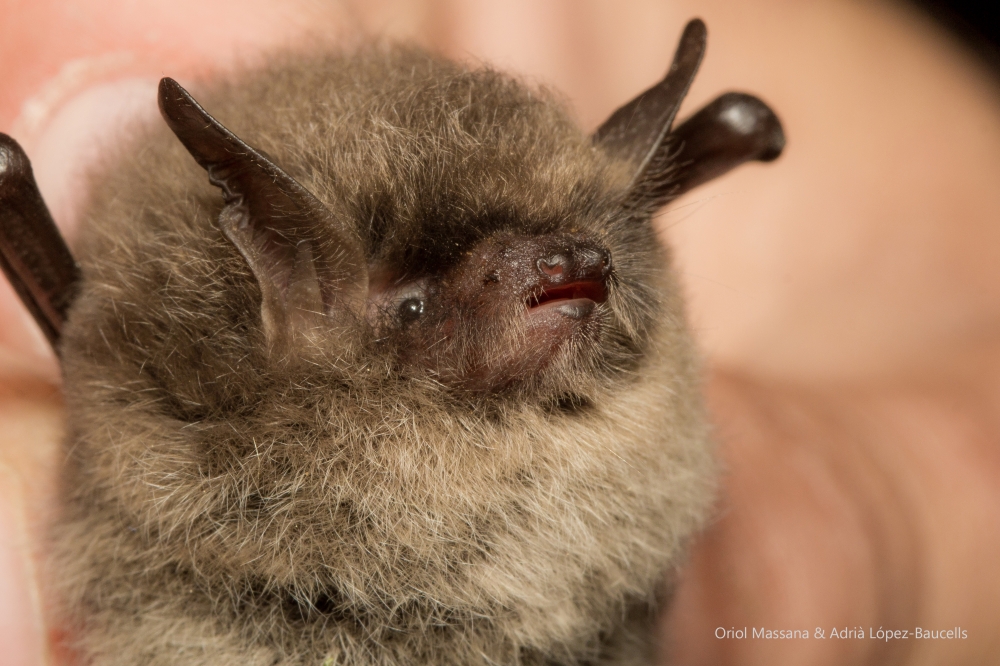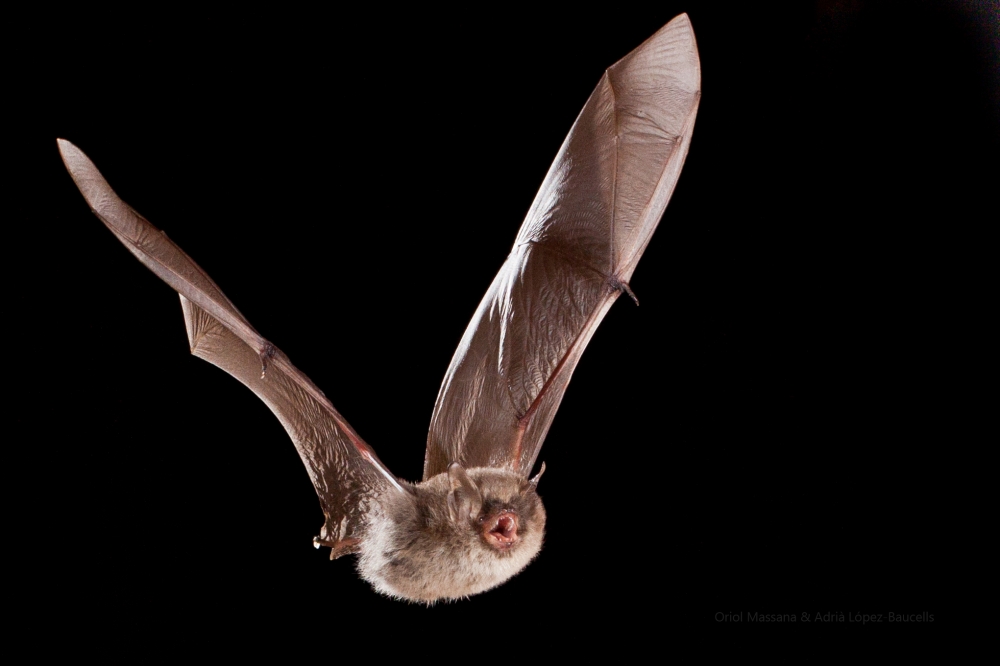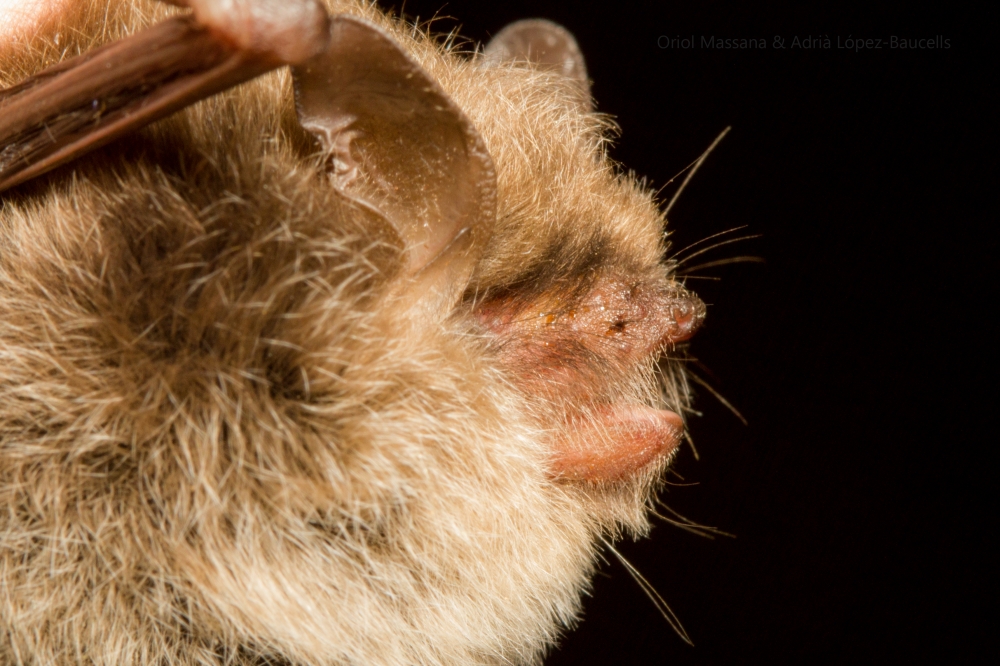Alcathoe whiskered bat

Myotis alcathoe (Helversen & Heller, 2001)
Vespertilionidae
Data defficient
| Other names | |
|---|---|
| Catalan | Rater de bigotis petit |
| Spanish | Murciélago ratonero bigotudo pequeño |
| English | Alcathoe whiskered bat |
| French | Murin d'Alcathoe |
| Basque | Alcathoe saguzar bibotedun |
| Galician | Morcego bigotudo pequeno |
Description
The smallest bat in the Myotis genus in Europe, with a total length ranging from 39 to 44 mm (body and head), a forearm spanning between 29 and 35 mm (averaging 31.8 mm in males and 32.1 mm in females), a wingspan of about 200 mm, a tail measuring between 36 and 37 mm, and a weight between 3.5 and 5.5 grams. Its dorsal coloration is brown (reddish at the tips), contrasting with the more gray or brown ventral side. Juveniles have a darker brown or gray colouration compared to adults. The wing membranes are typically dark brown or gray, while the skin is more pinkish, especially in adults. The face is covered with fur, and the ears are short (11 to 14 mm) and light-coloured, with a short and pointed tragus.
Despite its resemblance to the whiskered bat (Myotis mystacinus) and Brandt's bat (Myotis brandtii), the Alcathoe whiskered bat is easily distinguishable by its smaller size.
Fotografies
Distribution
They are known throughout Europe, although their distribution is highly fragmented and limited to areas with suitable habitats. Their distribution limits reach the south of Sweden and the north of Spain. They have also been found in Brittany, Ukraine, Georgia, Armenia, and western Turkey.
Roosts and phenology
The maternity colonies are found in mature and well-preserved forests, forming small groups of a few dozen individuals, although in the Czech Republic, groups of up to 83 individuals have been found. Their breeding shelters are typically in tree crevices, behind the bark, and possibly in buildings (with wooden beams), usually at heights of about 15 to 22 meters. The trees are usually pines, although also in linden and birch trees. Males are usually solitary and use all kinds of trees. The breeding colonies often change shelters very frequently, almost daily. Pregnant females have been found until mid-July, which is when the pups are usually born.
Their migratory patterns are unknown, but in general, it is assumed to be a sedentary species. This species reaches swarming shelters from early to mid-August, where they mate. In winter, they can be found in all kinds of underground cavities, although it is possible that they also hibernate in trees or in small cavities in forests.
Habitat and diet
The Alcathoe whiskered bat is the European bat species more adapted to wilder European habitats. Typical habitats include mature and well-preserved forests, structurally rich deciduous forests with streams, riparian forests, and mountain forests. It often uses mature oak groves with an abundance of old trees. Despite limited information, it seems to be associated with ravines and streams in preserved mid to low mountain forest environments. It appears to be found in forests also used by Bechstein's bat (Myotis bechsteinii) and Brandt's bat (Myotis brandtii).
Its diet consists largely of nocturnal lepidopterans (moths) less than 12 mm in size and dipterans such as mosquitoes. Beetles, other dipterans, ants, and arachnids seem to be locally important items in the diet. Prey is mostly captured in flight. Radio-marked individuals appear to feed over oak groves. In the early evening, it seems to visit water points near the shelter, where it hunts over the water but under branches of the rich adjacent vegetation.
Echolocation
Their echolocation calls consist of highly modulated and short calls with a typical structure of Myotis species, which is why it is included in the phonic group Myotis 50. Additionally, M. alcathoe presents broad frequency ranges, starting its calls at around 120 kHz and then sweeping down to 43 or 46 kHz, almost always remaining above 40 kHz. The frequency of maximum intensity or energy (FME) can oscillate between 40 and 80 kHz. The calls are weak and difficult to detect at more than 10 meters away. Individuals emerging from the shelter usually echolocate above the frequency detected by most handheld detectors.
Status
According to the IUCN Red List, this species lacks enough information for its classification within a specific threat category; therefore, it is categorized as Data Deficient. Nevertheless, the species is protected by the Eurobats Agreement (UNEP), the Bern Convention, and the European Directive on Habitats and Species. It is also protected by national legislation in various countries. Given its clear association with well-preserved forest environments and the drastic reduction of these habitats, it is often considered to be highly threatened. Habitat fragmentation and the limited ability to colonize new areas are its main threats. At the European level, logging and the disappearance of older forests are potentially significant threats. Surprisingly, this species experiences high mortality in structures such as roads and highways, and it tends to use underground passages when available.


